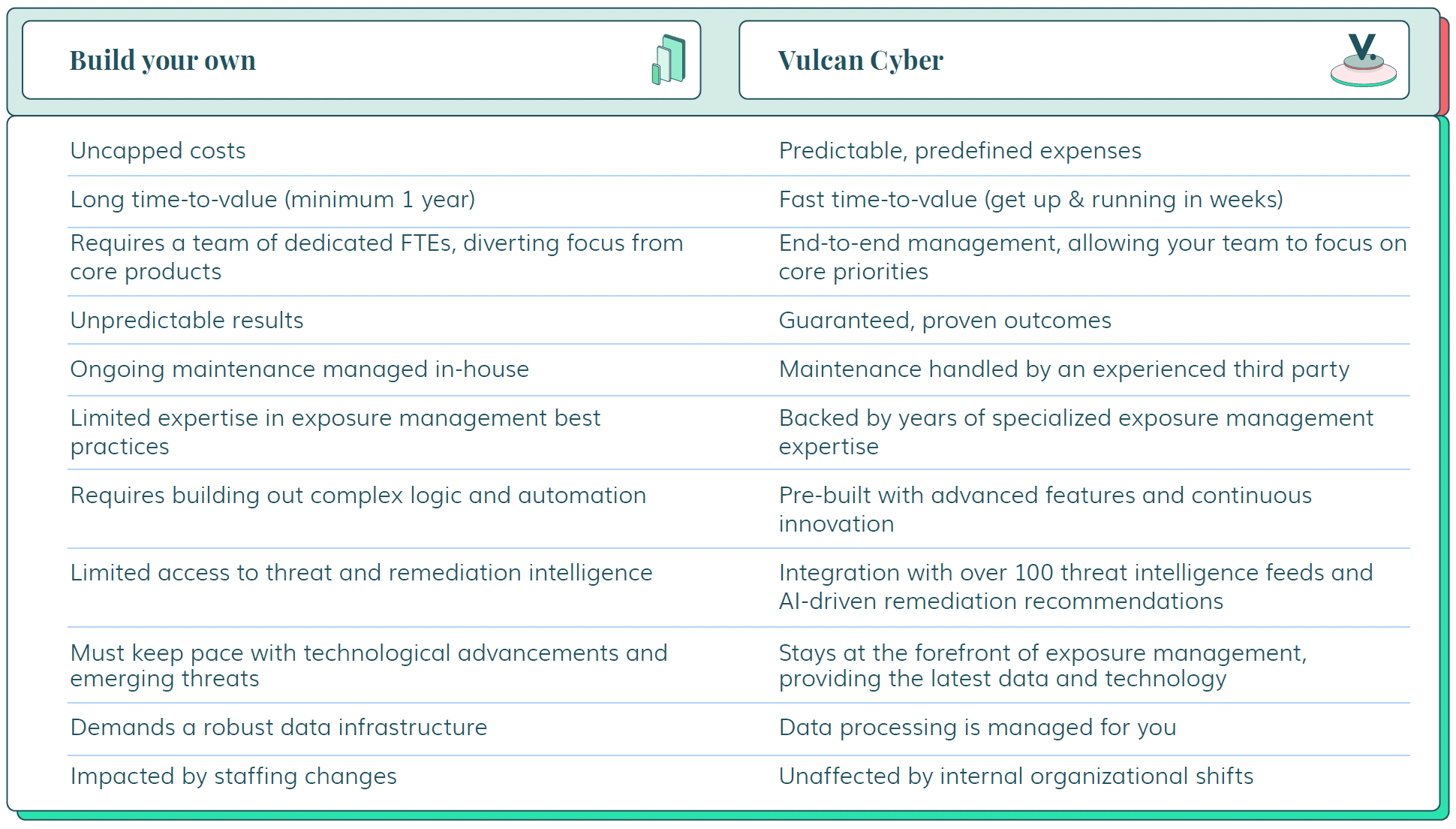-
Platform
OVERVIEW
Capabilities
-
Solutions
USE CASES
-
Cyber Risk Hub
LIBRARY
-
Company
GET TO KNOW US
-
Pricing
Should you build your own exposure management platform or invest in a proven solution? At Vulcan Cyber, we’ve seen firsthand how this decision can shape outcomes—and we’re here to guide you through the considerations.

Every organization faces its own challenges with managing vulnerabilities and mitigating cyber risks. With constant pressure to reduce exposure risk and enhance SecOps efficiency, one pivotal question comes up: should you build your own exposure management platform or invest in a proven solution? At Vulcan Cyber, we’ve seen firsthand how this decision can shape outcomes—and we’re here to guide you through the considerations.

The idea of building an exposure management platform in-house can be incredibly appealing. The promise of tailored functionality, full control, and potentially saving on licensing costs often drives this decision. However, as we’ve learned from our own journey, building such a platform is far from simple. From selecting the right database to designing a robust data schema, and even managing API errors at scale, we’ve encountered the kind of challenges that many organizations underestimate. In this blog, we’ll explore why these obstacles can make the build option more complex—and costly—than it first appears.
Risk data doesn’t come neatly organized. You’re pulling from a mix of sources—security scanners, cloud providers, and asset inventories—each with its own formats and reliability issues. Normalizing and correlating these disparate data sources into actionable insights is a monumental task. High-volume data processing requires a robust infrastructure and advanced data handling capabilities, not to mention costly computational resources. On top of this, data access and authorization become critical considerations. Not everyone within an organization should have visibility into the same vulnerability data. Implementing precise controls to ensure the right people see the right information adds another layer of complexity to building a platform in-house.
Security data from scanners represents just one piece of the exposure risk puzzle. To fully understand potential impact, organizations must incorporate environmental business context and up-to-date threat intelligence. This holistic approach is critical not only for effective prioritization but also for remediation, as it uncovers the root causes of security issues and pinpoints the most impactful fixes. Achieving this requires integration with multiple threat intelligence feeds or the costly addition of a dedicated security researcher to correlate temporal intelligence with security findings.
Exposure management isn’t just about visibility; it’s about action. Automating processes like calculating holistic risk scores, prioritizing vulnerabilities, adjusting SLA deadlines, assigning ownership, opening remediation tickets, managing risk acceptance, and more, demands sophisticated algorithms and deep integration with existing workflows. Building such automation from the ground up often takes years and requires ongoing maintenance to keep it operational and effective.
APIs evolve, technologies advance, and new vulnerabilities emerge every day. Staying compatible and effective requires constant updates, enhancements, and dedicated resources. Without these ongoing efforts, your exposure management solution will end up falling short, leaving gaps in your exposure management program. Beyond this, foundational decisions like choosing the right database or determining whether a data warehouse is necessary can significantly impact the scalability and performance of your solution. An incorrect choice here can lead to inefficiencies, bottlenecks, and costly reworks down the line.
What happens when key developers or team members leave? Organizational knowledge loss can be a significant risk, especially for custom-built platforms. Onboarding new talent to manage and maintain these systems is both time-consuming and expensive, potentially slowing your response to emerging threats. Additionally, consider how many stakeholders need to be involved in sustaining such a solution. Do you need support from the IT team? How will reporting formats align with the needs of different departments? Effective communication across multiple teams becomes essential to ensure the platform meets its objectives—but coordinating these efforts can introduce delays, inefficiencies, and even misalignment.
It isn’t easy to get to a good level of vulnerability management at scale with a do-it-yourself approach. You could try to implement that on a small scale, but go for Vulcan Cyber if you’re trying to implement it on a large scale.”
Cybersecurity Architect, Large tech enterprise
Off-the-shelf exposure management platforms are built by specialists who understand the complexities of vulnerability and risk management. Here’s why buying might be the smarter option:
Exposure management platforms are designed to plug right into your existing tools and workflows, so you can start tackling exposure risks in weeks—not years. Everything you need, from prioritization to tracking, is already set up and ready to go.
Established platforms have been tried and tested across industries, company sizes, and environments. They’re proven to work, so you don’t have to worry about unexpected bugs or inefficiencies derailing your efforts. Working with external vendors also provides a ‘throat to choke’, meaning a clear point of accountability. If issues arise, you have a dedicated partner responsible for resolving them promptly.
As your business scales or adopts new tech, off-the-shelf solutions adapt right alongside you. Whether you’re adding IoT devices, moving to the cloud, launching new products, or growing your team, these platforms handle the extra load without missing a beat.
Exposure management platforms come equipped with robust features like data deduplication, advanced risk scoring, real-time threat intelligence, and customizable remediation workflows—capabilities that would take years to develop in-house. On top of that, the software is constantly updated with cutting-edge advancements, including AI, large language models (LLMs), and more, keeping you ahead of the curve.
When you buy a platform, you’re not on your own. Vendors offer around-the-clock support, regular updates, and patches to handle new vulnerabilities. They’re also focused on staying ahead of the threat landscape, so your tools stay sharp while you focus on securing your business.
Going with an off-the-shelf exposure management platform means you get a reliable, scalable, and feature-rich solution backed by expert support—without the headache of building and maintaining it yourself.
Building your own exposure management platform may seem like a way to gain control, but the hidden costs in time, resources, and risk often outweigh the benefits. Buying an established platform allows you to focus on what matters most: protecting your organization from threats and reducing your risk exposure effectively.
At Vulcan Cyber, we’re here to help you evaluate your needs and deliver a solution that fits.
Ready to take the first step toward comprehensive exposure management?